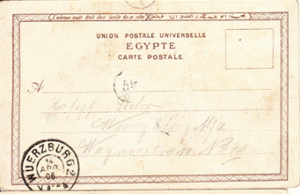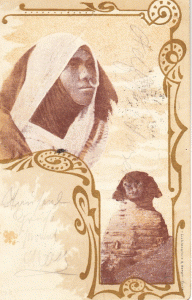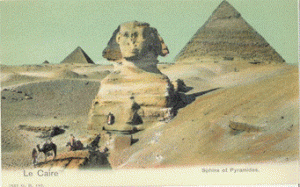Lichtenstern, Joseph & David Harari, (Cairo), ‘Sphinx and oriental woman’ 1902-1906, lithograph, 14,2 x 9 cm.
Around 1900, the system of sending a post card was a bit different: the back side was only available for the adress, here to Jungfrau Behr in the Wagnerstrasse in Wuerzburg. The post stamp reveals the date, April 14 1906, so the card was printed before that year.

The front the lower left corner offers place for a –small- message, with a decorative border isolating it from the photo collage. The Austian Joseph Lichtenstein started a post card business in Egypt in 1895. Although he considered himself a Western, he lived his entire life in Egypt and was even buried there.(1) His business went well and he invited the Syrian David Harari to become his business partner in 1902 .
The oriental woman became, like in other post cards from this time, a common subject for their post cards, often soft pornographic with nakes breasts. Here the woman is veiled, her exotic nature confirmed by ornate jewelry of the nose ring. Yet, the typical Egyptian feature was a leather tube over the bridge of her nose, this type of jewelry in fact was worn by Sudanese women.
Below her, the headdress is repeated by the archeological one adorning the head of the great Giza sphinx. From the specific viewpoint and the small man in jelabiyah standing on the lower part, a post card containing the original photo can be identified.
Literature:
Starr, Deborah, Remembering Cosmopolitan Egypt: Literature, Culture, and Empire. London/New York: Routledge 2009.
Vogelsang-Eastwood, Gillian, Veiled Images. Rotterdam: Barjesteh, Meeuwes & Co / Syntax Publishers 1996.

